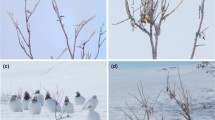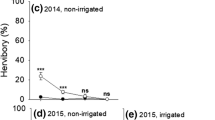Abstract
“Grazing lawns” are well-known effects of large mammalian herbivores on a short grass sward that is maintained through a positive feedback effect; plants are re-grazed due to their increased palatability. However, there are few studies that have addressed the notion of “browsing lawns.” I simulated browsing and added nutrients to Acacia nigrescens, a palatable and dominant African tree, to examine the effects on the architecture of these trees in a greenhouse. I recorded investments in non-structural carbohydrates and crude protein between roots and stems as a possible mechanism behind such architectural changes. There was a significant decrease in mean branch internode length and an increase in the branching ratio with clipping; the last mentioned indicated that there was more extensive tree branching. There were no significant effects on plant architecture of nutrient addition. There were changes in non-structural carbohydrates and crude protein between the roots and stems due to clipping but not to nutrient addition. Non-structural carbohydrate concentrations decreased with clipping in the roots and increased in the stems. Crude protein decreased in the stems with clipping frequency but not in the roots. There was an increase in root:shoot ratio of crude protein with increasing clipping frequency. A. nigrescens performs like a browsing lawn because of the changes in tree architecture (mean branch internode length and branching ratio) that are consistent with clipping. Clipping but not nutrient addition was important for these trees. Clipping frequency was important for non-structural carbohydrate redistribution from roots to stems. A positive feedback could have long-term effects on the palatability of these trees which should cause large mammalian herbivores to consistently favor A. nigrescens.




Similar content being viewed by others
References
Albert CH, Grassein F, Schurr FM, Vieiledent G, Violle C (2011) When and how should intraspecific variability be considered in trait-based plant ecology? Persp Plant Ecol Evol Syst 13:217–225
Archibald S, Bond WJ (2003) Growing tall vs. growing wide: tree architecture and allometry of Acacia karroo in forest, savanna, and arid environments. Oikos 102:3–14
Barthelemy D, Caraglio Y (2007) Plant architecture: a dynamic, multilevel and comprehensive approach to plant form, structure and ontogeny. Ann Bot 99:375–407
Bond WJ, Loffell D (2001) Introduction of giraffe changes acacia distribution in a South African savanna. Afr J Ecol 39:286–294
Canadell J, Lopez-Soria L (1998) Lignotuber reserves support regrowth following clipping of two Mediterranean shrubs. Funct Ecol 12:31–38
Canham CD, Kobe RK, Latty EF, Chazdon RL (1999) Interspecific and intraspecific variation in tree seedling survival: effects of allocation to roots versus carbohydrate reserves. Oecologia 121:1–11
Chapin FS, Schulze ED, Mooney HA (1990) The ecology and economics of storage in plants. Ann Rev Ecol Syst 21:423–447
Cherbuy B, Joffre R, Gillon D, Rambal S (2001) Internal remobilization of carbohydrates, lipids, nitrogen and phosphorus in the Mediterranean evergreen oak Quercus ilex. Tree Physiol 21:9–17
Cromsigt JPGM, Kuiper DPJ (2011) Revisiting the browsing lawn concept: evolutionary interactions or pruning herbivores? Persp Plant Ecol Evol Syst 13:207–215
Donohue K (2003) Setting the stage: phenotypic plasticity as habitat selection. Int J Plant Sci 164:S79–S92
Du Toit JT (2003) Large herbivores and savanna heterogeneity. In: Du Toit JT, Rogers K, Biggs H (eds) The Kruger experience: ecology and management of savanna heterogeneity. Island Press, Washington, DC, pp 292–309
Du Toit JT, Olff H (2014) Generalities in grazing and browsing ecology: using across-guild comparisons to control contingencies. Oecologia 174:1075–1083
Du Toit JT, Bryant JP, Frisby K (1990) Regrowth and palatability of Acacia shoots following pruning by African savanna browsers. Ecology 71:140–154
Farnsworth KD, Niklas KJ (1995) Theories of optimization, form and function in branching architecture in plants. Funct Ecol 9:355–363
Fornara DA, Du Toit JT (2007) Browsing lawns? Responses of Acacia nigrescens to ungulate browsing in an African savanna. Ecology 88:200–209
Fornara DA, Du Toit JT (2008) Responses of woody saplings exposed to chronic mammalian herbivory in an African savanna. Ecosci 15:129–135
Gordijn PJ, Rice E, Ward D (2012) The effects of fire on woody plant encroachment are exacerbated by succession of trees of decreased palatability. Persp Plant Ecol Evol Syst 14:411–422
Hean J, Ward D (2012) Fire and herbivory are not substitutable: evidence from regrowth patterns and changes in physical and chemical defences in Acacia seedlings. J Veg Sci 23:13–23
Johnston DB, Cooper DJ, Hobbs NT (2007) Elk browsing increases aboveground growth of water-stressed willows by modifying plant architecture. Oecologia 154:467–478
Kim TH, Ourry A, Boucaud J, Lemaire G (1991) Changes in source-sink relationship for nitrogen during regrowth of lucerne (Medicago sativa L.) following removal of shoots. Austr J Plant Physiol 18:593–602
Lavorel S, Diaz S, Cornelissen JHC, Garnier E, Harrison SP, McIntyre S, Pausas JG, Perez-Harguindeguy N, Roumet C, Urcelay C (2007) Plant functional types: are we getting any closer to the Holy Grail? In: Canadell JG, Pataki DDE, Pitelka LF (eds) Terrestrial ecosystems in a changing world. Springer, Berlin, pp 171–186
Marais JP (1979) Evaluation of acid hydrolysis procedures for the rapid determination of total non-structural carbohydrates in plant species. Agrochemophys 11:1–3
Marais JP, De Wit JL, Quicke GV (1966) A critical evaluation of the Nelson-Somogyi method for the determination of reducing sugars. Anal Biochem 15:373–381
Martinez AJ, Lopez-Portillo J (2003) Growth and architecture of small honey mesquites under jackrabbit browsing: overcoming the disadvantage of being eaten. Ann Bot 92:365–375
Matejovic I (1996) The application of Dumas method for determination of carbon, nitrogen, and sulphur in plant samples. Rostlinna Vyroba 42:313–316
McNaughton SJ (1984) Grazing lawns: animals in herds, plant form, and coevolution. Am Nat 124:863–886
Moncrieff GR, Chamaille-Jammes S, Higgins SI, O’Hara RB, Bond WJ (2011) Tree allometries reflect a lifetime of herbivory in an African savanna. Ecology 92:2310–2315
Mopper S, Maschinski J, Cobb N, Whitham TG (1991) A new look at habitat structure: consequences of herbivore-modified plant architecture. In: Bell SS, McCoy ED, Mushinsky H (eds) Habitat structure. Chapman and Hall, London, pp 260–280
Niklas KJ, Spatz HC (2004) Growth and hydraulic (not mechanical) constraints govern the scaling of tree height and mass. Proc Nat Acad Sci USA 101:15661–15663
Pastor J, De Jager NP (2012) Simulated responses of moose populations to browsing-induced changes in plant architecture and forage production. Oikos 122:575–582
Schlichting CD, Pigliucci M (1998) Phenotypic evolution: a reaction norm perspective. Sinauer Associates, Sunderland, MA
Schutz AE, Bond WJ, Cramer MD (2009) Juggling carbon: allocation patterns of a dominant tree in a fire-prone savanna. Oecologia 160:235–246
Scogings P, Macanda M (2005) Acacia karroo responses to early dormant season defoliation and debarking by goats in a semi-arid subtropical savanna. Plant Ecol 179:193–206
Scogings P, Mamashela TC, Zobolo AM (2013) Deciduous sapling responses to season and large herbivores in a semi-arid African savanna. Austral Ecol 38:548–556
Smit GN (1999) Acacias of South Africa. Briza Press, Pretoria
Staver AC, Bond WJ, Cramer MD, Wakeling JL (2012) Top-down determinants of niche structure and adaptation among African Acacias. Ecol Lett 15:673–679
Stock WD, Bond WJ, Van De Vijver CADM (2010) Herbivore and nutrient control of lawn and bunch grass distributions in a southern African savanna. Plant Ecol 206:15–27
Sultan SE (2003) Phenotypic plasticity in plants: a case study in ecological development. Evol Dev 5:25–33
Thornton B, Millard P (1997) Increased defoliation frequency depletes remobilization of nitrogen for leaf growth in grasses. Ann Bot 80:89–95
Van Der Heyden F, Stock WD (1995) Nonstructural carbohydrate allocation following different frequencies of simulated browsing in three semi-arid shrubs. Oecologia 102:238–245
Van Der Heyden F, Stock WD (1996) Regrowth of a semiarid shrub following simulated browsing: the role of reserve carbon. Funct Ecol 10:647–653
Waldram MS, Bond WJ, Stock WD (2008) Ecological engineering by a mega-grazer: white rhino impacts on a South African savanna. Ecosyst 11:101–112
Ward D (2010) The effects of apical meristem damage on growth and defences of two Acacia species in the Negev desert. Evol Ecol Res 12:589–602
Ward D, Shrestha MK, Golan-Goldhirsh A (2012) Evolution and ecology meet molecular genetics: adaptive phenotypic plasticity in two isolated Negev desert populations of Acacia raddiana at either end of a rainfall gradient. Ann Bot 109:247–255
West GB, Brown JH, Enquist BJ (1999) The fourth dimension of life: fractal geometry and allometric scaling of organisms. Science 284:1677–1679
Wigley BJ, Cramer MD, Bond WJ (2009) Sapling survival in a frequently burnt savanna: mobilization of carbon reserves in Acacia karroo. Plant Ecol 203:1–11
Wigley B, Bond WJ, Fritz H, Coetsee C (2015) Mammal browsers and rainfall affect Acacia leaf nutrient content, defense, and growth in South African savannas. Biotropica 47:190–200
Acknowledgments
I would like to thank Alison Young for her assistance in the greenhouse and Tamanna Patel and Kayleigh Muller for their laboratory assistance. The National Research Foundation of South Africa funded this study. I thank the anonymous reviewers for their useful comments on this manuscript.
Author information
Authors and Affiliations
Corresponding author
Ethics declarations
Conflict of interest
There is no conflict of interest for this manuscript.
Additional information
Communicated by E. T. F Witkowski.
Rights and permissions
About this article
Cite this article
Ward, D. Clipping frequency but not nutrients affect the architecture and non-structural carbohydrates of a browsing lawn. Plant Ecol 217, 21–29 (2016). https://doi.org/10.1007/s11258-015-0555-8
Received:
Accepted:
Published:
Issue Date:
DOI: https://doi.org/10.1007/s11258-015-0555-8




